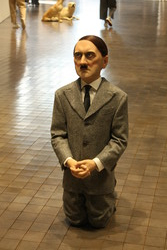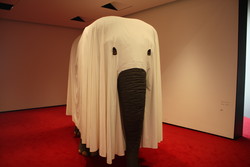There are images that often come to mind when you think of museums, the silence or beautiful oil paintings. Mauricio Cattelan cynically and sometimes humorously destroys these common ideas, opening a new perspective through his works. Cattelan is no doubt an artist who gives people new surprises by freely using sensitive subjects such as religion. Let's go to the exhibition <Maurizio Cattelan: WE> to see his shocking and fresh works.
1. Here Is Cattelan


Born poor in Padua, Italy in 1960, Cattelan started art and became widely known for his hyper realistic sculptures and installations. Cattelan wittily conveys stories about public stereotypes and social issues through models of his own face. You can encounter various ‘Cattelans’ through the exhibition here and there. First, there is a work in which a male model resembling Cattelan sticks his head out through the floor of the exhibition hall. This work shows the man invading the art museum through an abnormal route, which represents Cattelan himself invading the art world with unprecedented ideas. In the center of the exhibition hall, the work ‘We’ welcomes the audience. Two men are lying side by side on a bed as if they were dead. The faces of these models have a striking resemblance to Cattelan. The dark-colored suits, their pale expressions, and neatly gathered legs and arms are reminiscent of a funeral. In contemporary art, the artist's identity is also used as artistic practice, and the double self-portrait of 'We' allows people, who both fear death but cannot ignore it, to look into the contradictions through a homage of life and death. Lastly, the work ‘Charlie’ is a model of a boy who resembles Cattelan’s childhood. ‘Charlie’ rides a tricycle through the museum and between the visitors. Breaking the silence of the art museum where loud noise or approaching the artwork is usually prohibited, this work can be seen as Cattelan's self-portrait challenging the public eye or established artistic conventions. At the same time, 'Charlie' also makes people reflect on how much our society is impatient of childhood innocence and whether pure hearts are being kept safe.
2. What You Think Of: The Society in Cattelan’s Eye


In Cattelan's exhibition, there are many works that might elicit different opinions from person to person. His work, ‘The Ninth Hour’, depicts Pope John Paul II lying on the ground after being struck by a meteorite. The name of the work means the ninth hour from sunrise, which is around 3:00 PM when Jesus was crucified on the cross. This work is often seen as a mockery of religion in that it shows Pope John Paul II, who was revered by many people, as an unholy figure. At the same time, the work which portrays Catholicism in a comical way, raises questions about social authority and customs and makes us reflect on the meaning of religion and its impact on the world. Now let’s look at the work ‘Him’. When viewed from the back, it looks like a child kneeling down to pray, but when viewed from the front, the audience surprisingly realizes that the face of the model is Hitler, who massacred millions of Jews. Cattelan reminds people of our terrible history once again by imitating the face of a cruel villain. ‘Him’ also successfully shows the inner evil side that can exist in a boy and in religion, also with the existing duality of man by contrasting the back of a devout and harmless boy with the front of a famous villain. The work ‘It’ has the shape of a black cat turning its back, facing the corner of the wall. Mainly, black cats have been shunned in various cultures because they were thought to bring bad luck simply because of their color. Representatively, “The Black Cat” in Edgar Allan Poe’s novel enhances the spooky atmosphere of the work. However, in the recent animation ‘Ladybug’, the character who appears as a hero takes on the appearance of a black cat, and in various cultural contents black cats are starting to be portrayed with a positive perception, overturning the past image. Through this work in which the cat is sometimes portrayed as a lucky cat or an object of avoidance for no logical reason, the audience can think about the standard of evil and good, and reflect on whether they have turned their back on someone through wrong prejudice.
3. We: the theme


‘All’ is a work composed of nine sculptures placed side by side on the floor, and gives a look that anyone can recall with nine corpses covered with cloth. The work reminds us of disasters that we often face indirectly through the media. At the same time, the public can remember the recent tragedy that happened in Korea. In this way, the work makes the audience think about the death they face as a community. ‘Not Afraid of Love’ is a shape of a baby elephant wearing a white cloth with small cuts only on the eyes and nose. This work symbolizes various things. First of all, we can think of the idiom ‘elephant in the room’, which refers to a problem that everyone knows but does not openly talk about. In other words, it makes it possible to think about implicit social problems. It is also reminiscent of the Ku Klux Klan (KKK), an American white supremacist group that traditionally wears white clothes. Either way, this elephant covered with white cloth clearly implies huge social conflicts not mentioned by the public, and makes people think about how to deal with it.
Cattelan's exhibition certainly makes us think about various things, and proudly depicts things that we usually feel uncomfortable with, making people think about why certain topics have become difficult to bring out of our mouths. Cattelan helps us ponder why the inner fence that blocked the ways to explore more broadly and the norms we had unknowingly grew, and question who it was that planted them in us. To see the story of ‘us’ that Cattelan depicts, let's go to the exhibition <Maurizio Cattelan: WE>.
Dates: 2023.01.31. ~ 2023.07.16.
Hours: Tue, Wed, Thu, Fri, Sat, Sun 10:00~ 18:00 (Can enter from the selected viewing time until the next viewing time)
*Closed on every Monday,
* Online individual reservations can be made 14 days prior to the viewing date, and the maximum number of people who can make individual reservations is 4 people.
Place: Leeum Museum of Art
Ticket Prices: Free
Contact: 02-2014-6900

